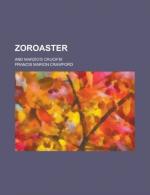And yet the uneasiness grew upon him. He felt somehow as though Paolo were present in the room with him, watching him over his shoulder, suggesting improvements to be made, in that voice of his which now rang distinctly in the artist’s ear. His imagination worked morbidly, and he thought of Paolo standing beside him, ordering him to do this or that against his will, until he began to doubt his own judgment in regard to what he was doing. He wondered whether he should feel the same thing when Paolo was dead. Again he looked behind him, and the idea that he was not alone gained force. Nevertheless the room was bright, brighter indeed in the afternoon than it ever was in the morning, for the window was towards the south, and though the first rays of the sun reached it at about eleven in the morning, the buildings afterwards darkened it again until the sun was in the west. Moreover to-day, the weather had been changeable, and it had rained a little about noon. Now the air was again clear, and the workshop was lit up so that the light penetrated even to the ancient cobwebs in the corners, and touched the wax models and casts on the shelves, and gilded the old wood of the door opposite with rich brown gold. Marzio had a curtain of dusty grey linen which he drew across the lower part of the window to keep the sunshine off his work.
He was impatient with himself, and annoyed by the persistency of the impression that Paolo was in some way present in the place. As though to escape from it by braving it he set himself resolutely to consider the expediency of destroying his brother. The first quick impulse in the morning had developed to a purpose in the afternoon. He had constructed the probable occurrences out of the materials of his imagination, and had done it so vividly as to frighten himself. The fright had in some measure cooled his intention, and had been now replaced by a new element in his thoughts, by the apprehension for the future if the deed were accomplished. He began to speculate upon what would happen afterwards, wondering whether by any means the murder could be discovered, and if in that case it could ever be traced to him.
At the first faint suggestion that such a thing as he was devising could possibly have another issue than he had supposed, Marzio felt a cold sensation in his heart, and his thoughts took a different direction. It was all simple enough. To get Paolo into the workshop alone—a blow—the concealment of the dead body until night—then the short three hundred yards with the hand-cart—it seemed very practicable. Yes, but if by any chance he should meet a policeman under those low trees in the Piazza de’ Branca, what would happen? A man with a hand-cart, and with something shapeless upon the hand-cart, in the dark, hurrying towards the river—such a man would excite the suspicions of a policeman. Marzio might be stopped and asked what he was taking away. He would answer—what would he answer in such a case? The hand-cart would be examined and found to contain a dead priest. Besides, he reflected that the wheels would make a terrible clatter in the silent streets at night. Of course he might go out and walk down to the river first and see if there was anybody in the way, but even then he could not be sure of finding no one when he returned with his burden.




